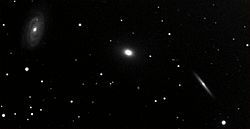NGC 5982
| NGC 5982 | |
|---|---|
 NGC 5982 by Hubble Space Telescope | |
| Observation data (J2000 epoch) | |
| Constellation | Draco |
| Right ascension | 15h 38m 39.8s[1] |
| Declination | +59° 21′ 21″[1] |
| Redshift | 0.010064 ± 0.000031[1] |
| Heliocentric radial velocity | 3,017 ± 9 km/s[1] |
| Distance | 123 ± 34 Mly (37.6 ± 10.5 Mpc)[1] |
| Apparent magnitude (V) | 11.0[2] |
| Characteristics | |
| Type | E3[1] |
| Apparent size (V) | 3.0′ × 2.1′[1] |
| Other designations | |
| UGC 9961, CGCG 297-024, MCG +10-22-029, PGC 55674[1] | |
NGC 5982 is an elliptical galaxy located in the constellation Draco. It is located at a distance of circa 130 million light years from Earth, which, given its apparent dimensions, means that NGC 5982 is about 100,000 light years across. It was discovered by William Herschel on May 25, 1788.[3]
NGC 5982 has a kinematically decoupled nucleus, with its major axis being nearly perpendicular to the rotation of the galaxy.[4] NGC 5982 features many shells in its envelope, nearly 26. The shells form circular arcs, with the further being located at a radius of 150 arcseconds along the major axis of the galaxy,[5] while the innermost one lies 8 arcseconds off the nucleus.[6] The shells and the kinematically decoupled nucleus are the result of the merger of the elliptical galaxy with a small elliptical galaxy.[5]
The galaxy has globular clusters that belong in two populations, red and blue. The age of the globular clusters in NGC 5982 is over 5 billion years.[7] The luminosity of NGC 5982 is dominated by light emitted by old stars.[5] In the centre of NGC 5982 lies a supermassive black hole whose mass is estimated to be 8.3×108 M☉ (108.92 M☉) based on the M–sigma relation.[8] The nucleus may display low level activity and has been categorised as a possible LINER.[9][5]

NGC 5982 belongs to a galaxy group known as the NGC 5982 group. Other members of the group include the galaxies NGC 5976, NGC 5981, NGC 5985, NGC 5987, and NGC 5989.[10] NGC 5981, a spiral galaxy seen edge-on, lies at a separation of 6.3 arcminutes from NGC 5982 and NGC 5985, a spiral galaxy seen face-on, lies at a separation of 7.7 arcminutes.[11] The three galaxies are known as the Draco Trio or the Draco Group, although there is no evidence that they form a compact group.[12]
References
[edit]- ^ a b c d e f g h "NASA/IPAC Extragalactic Database". Results for NGC 5982. Retrieved 2016-01-18.
- ^ "Revised NGC Data for NGC 5982". spider.seds.org. Retrieved 25 November 2018.
- ^ Seligman, Courtney. "NGC 5982 (= PGC 55674)". Celestial Atlas. Retrieved 19 November 2018.
- ^ Emsellem, Eric; Cappellari, Michele; Peletier, Reynier F.; McDermid, Richard M.; Bacon, R.; Bureau, M.; Copin, Y.; Davies, Roger L.; Krajnović, Davor; Kuntschner, Harald; Miller, Bryan W.; de Zeeuw, P. Tim (11 August 2004). "The SAURON project – III. Integral-field absorption-line kinematics of 48 elliptical and lenticular galaxies". Monthly Notices of the Royal Astronomical Society. 352 (3): 721–743. arXiv:astro-ph/0404034. Bibcode:2004MNRAS.352..721E. doi:10.1111/j.1365-2966.2004.07948.x. S2CID 13202056.
{{cite journal}}:|last6=has generic name (help) - ^ a b c d del Burgo, C.; Carter, D.; Sikkema, G. (6 November 2007). "Spatial distribution of dust in the shell elliptical NGC 5982". Astronomy & Astrophysics. 477 (1): 105–116. doi:10.1051/0004-6361:20077925.
- ^ Sikkema, G.; Carter, D.; Peletier, R. F.; Balcells, M.; del Burgo, C.; Valentijn, E. A. (26 March 2007). "HST/ACS observations of shell galaxies: inner shells, shell colours and dust". Astronomy & Astrophysics. 467 (3): 1011–1024. arXiv:astro-ph/0703588. Bibcode:2007A&A...467.1011S. doi:10.1051/0004-6361:20077078. S2CID 18392338.
- ^ Sikkema, G.; Peletier, R. F.; Carter, D.; Valentijn, E. A.; Balcells, M. (16 October 2006). "Globular cluster systems of six shell galaxies". Astronomy & Astrophysics. 458 (1): 53–67. arXiv:astro-ph/0606385. Bibcode:2006A&A...458...53S. doi:10.1051/0004-6361:20054606. S2CID 11803473.
- ^ Stone, Nicholas C.; Metzger, Brian D. (1 January 2016). "Rates of stellar tidal disruption as probes of the supermassive black hole mass function". Monthly Notices of the Royal Astronomical Society. 455 (1): 859–883. arXiv:1410.7772. Bibcode:2016MNRAS.455..859S. doi:10.1093/mnras/stv2281. S2CID 119308901.
- ^ Ho, Luis C.; Filippenko, Alexei V.; Sargent, Wallace L. W. (October 1997). "A Search for Dwarf Seyfert Nuclei. III. Spectroscopic Parameters and Properties of the Host Galaxies". The Astrophysical Journal Supplement Series. 112 (2): 315–390. arXiv:astro-ph/9704107. Bibcode:1997ApJS..112..315H. doi:10.1086/313041. S2CID 17086638.
- ^ Makarov, Dmitry; Karachentsev, Igor (21 April 2011). "Galaxy groups and clouds in the local (z~ 0.01) Universe". Monthly Notices of the Royal Astronomical Society. 412 (4): 2498–2520. arXiv:1011.6277. Bibcode:2011MNRAS.412.2498M. doi:10.1111/j.1365-2966.2010.18071.x. S2CID 119194025.
- ^ de Vaucouleurs, Gerard Henri; de Vaucouleurs, Antoinette; Shapley, Harlow (1964). Reference catalogue of bright galaxies. Austin: University of Texas Press. Bibcode:1964rcbg.book.....D.
- ^ "The Dragon Slayer - NGC 5985, NGC 5982, NGC 5981 by Ken Crawford". Universe Today. 10 September 2008.
External links
[edit] Media related to NGC 5982 at Wikimedia Commons
Media related to NGC 5982 at Wikimedia Commons- NGC 5982 on WikiSky: DSS2, SDSS, GALEX, IRAS, Hydrogen α, X-Ray, Astrophoto, Sky Map, Articles and images
- NGC 5982 on SIMBAD
